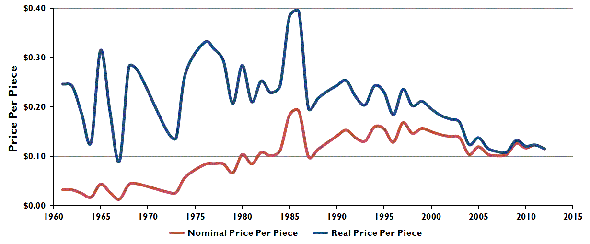From Reality Prose:
What Happened with LEGO
The price of a brick.... MUCH MORE
“What happened with Legos? They used to be simple. Oh come on, I know you know what I’m talking about. Legos were simple. Something happened out here while I was inside. Harry Potter Legos, Star Wars Legos, complicated kits, tiny little blocks. I mean I’m not saying it’s bad, I just wanna know what happened.” — Prof. Cane – Community
LEGO® sets are not cheap toys. They are made to the highest standards and have the price to go along with it. However, in the past couple decades it seems that the price of LEGO sets has become outrageous. New sets can sell for up to $500 retail and old sets can sell for twice that in a secondary market. This is a children’s toy, right? There is no way LEGO sets have always been this expensive; it is just molded plastic. Let’s take a look at the history of LEGO pricing and try to figure out what is going on.
Evaluating the price history of LEGO sets
In order to come to some sort of conclusion about the price of LEGO, I needed to get some data on the historic retail prices of LEGO sets. The best source of this information is brickset.com. This website has data on almost all LEGO sets ever made and the retail pricing for many of them. I wrote a web scraping program to go through the Brickset database and make a database of set information. In order to keep the results relevant, I decided to compile one set that fit two basic qualifications:
1) They have a price listed. Almost all sets since 1980 have their retail price listed as do many sets before that year.
- There is not a way to qualify the price of a LEGO brick without first knowing the price of the set the brick is in.
2) The set contains at least 25 pieces.
I then calculated the price per piece1 of each set and adjusted it for inflation. Finally I calculated the average of each year, adjusted for inflation, and put it into graph form. Figure 1 shows the results (prices are in US dollars).
- This is an arbitrary line but it is a line that needed to be drawn. There have been many promotional sets over the years which have very few pieces but carry a higher price because of their promotional status. These can range from keychains to individual minifigs to seasonal items. They are not representative of the typical price of a LEGO brick and therefore should not be included in the evaluation.
Figure 1 The average price per piece of a LEGO brick since 1960
Data on the price of sets before 1980 is lacking so I focused in on the data from 1980′s to the present as seen in Figure 2....
HT: Marginal Revolution
